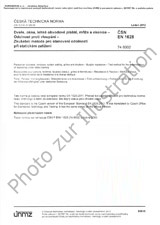Wir benötigen Ihre Einwilligung zur Verwendung der einzelnen Daten, damit Sie unter anderem Informationen zu Ihren Interessen einsehen können. Klicken Sie auf "OK", um Ihre Zustimmung zu erteilen.
ČSN ETSI EN 302099-V2.2.1 (872010)
Environmental Engineering (EE); Powering of equipment in access network
Name übersetzen
NORM herausgegeben am 1.7.2021
Informationen über die Norm:
Bezeichnung normen: ČSN ETSI EN 302099-V2.2.1
Zeichen: 872010
Katalog-Nummer: 512415
Ausgabedatum normen: 1.7.2021
SKU: NS-1028339
Zahl der Seiten: 48
Gewicht ca.: 144 g (0.32 Pfund)
Land: Tschechische technische Norm
Kategorie: Technische Normen ČSN
Kategorie - ähnliche Normen:
Die Annotation des Normtextes ČSN ETSI EN 302099-V2.2.1 (872010):
V2.2.1
The present document describes the principles for powering of Telecommunications Equipment (TE) in access networks (both traditional copper based and Next Generation fibre and/or hybrid based) and contains requirements for the powering systems, laying down:
- - the characteristics of the input and output interfaces of the power units; the recommendations for TE power protection, also regarding network integrity and public services availability requirements;
- - the management data, necessary to guarantee the required availability of the network and provided public services and to ensure the maintenance of the TE power units.
The present document takes into account the innovative characteristics of fibre-based access network equipment, for which the intrinsic limitation of the local power plants should be considered regarding the equipment installed inside telecom centre or local exchanges or installed in streets or inside buildings: it goes from "complete integration of the power plant in the TE" to "remote power feeding from a distant power plant".
The present document provides detailed information in annex A on the improved reliability of public electric power grid and on the improved reliability and availability of new fibre-based NGA network. It should be considered that, for street cabinet TE, the local power scenario is common and, in that case, the main power supply availability characteristics are mainly based on electrical energy provider´s performance.
The present document applies to the powering of all equipment of the access network (copper, fibre or radio networks) located inside or outside telecommunications centres or local exchanges, differentiating the applicable and sustainable power protection requirements. The access network is defined as the part of the telecommunications network, which comprises the network termination (passive or active) that is installed inside customer premises and the first exchange that can be also the broadband local exchange.
As innovative fibre-based and hybrid-based NGA network TE are changing the traditional powering paradigm, the present document proposes the viable measures to comply with the integrity, availability and uninterrupted telephone/VoIP provision that European regulatory defines for public networks [i.18].
The present document describes different configurations of powering the TE and the impacts on networks and services continuity and reliability:
- - Local power supply for TE (e.g. street cabinet, active network termination, etc.).
- - Remote Feeding to TE from central office through copper access pair.
- - Cluster Power supply feeding power for a cluster of TE.
- - Remote power feeding to TE from centre or cluster power through a power cable.
- - Back feeding or Reverse Powering architecture that can supply power to Access Network Units such as ONU or ONT or remote DSL unit from the customer premises through its final distribution access copper pair
Normansicht ČSN ETSI EN 302099-V2.2.1 (872010)
Empfehlungen:
Aktualisierung der technischen Normen
Wollen Sie sich sicher sein, dass Sie nur die gültigen technischen Normen verwenden?
Wir bieten Ihnen eine Lösung, die Ihnen eine Monatsübersicht über die Aktualität der von Ihnen angewandten Normen sicher stellt.
Brauchen Sie mehr Informationen? Sehen Sie sich diese Seite an.




 Cookies
Cookies
